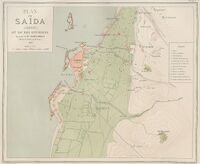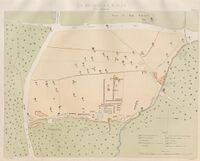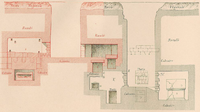Social:Tabnit sarcophagus
| Tabnit sarcophagus | |
|---|---|
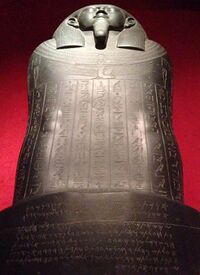 The sarcophagus in its current location | |
| Material | Basalt |
| Writing | Phoenician |
| Created | c.500 BC |
| Discovered | 1887 |
| Present location | Istanbul Archaeological Museums |
The sarcophagus, together with the Eshmunazar II sarcophagus, were possibly acquired by the Sidonians following their participation in the Battle of Pelusium (525 BC),[1] and served as models for later Phoenician sarcophagi.[2] The Phoenician text is considered to have a "remarkable" similarity to that of the Shebna inscription from Jerusalem.[3]
Discovery
At the beginning of 1887, Mehmed Sherif Effendi, the owner of a piece of land known as Ayaa, obtained a permit from the local authorities to quarry stone for the construction of a new building. On 2 March 1887, Cherif reported to the Kaymakam of Sidon, Sadik Bey, that he had discovered a well at the bottom of which there might be tombs. Sadik Bey examined the site and spotted a vault containing two sarcophagi through a hole in the eastern wall of the well. He escalated the matter to the Vali of Damascus, Rashid Nashid Pasha, and the Governor of Beirut Nassouhi Bey, and entrusted the well to the care of Essad Effendi from the gendarmerie of Sidon.[4]
According to the American missionary narrative, the tombs were discovered in 1887 by the American Presbyterian minister William King Eddy (the father of William A. Eddy). William Wright sent a letter to The Times with news of Eddy's discovery and imploring the British Museum to "take immediate measures to secure these treasures and prevent their falling into the hands of the vandal Turk". This alerted the new curator of the fledgling Istanbul Archaeological Museum, Osman Hamdi Bey, who arranged for a full excavation and the transfer of the sarcophagi to Istanbul.[5]
During the excavation, the workmen opened the Tabnit sarcophagus and found "a human body floating in perfect preservation in a peculiar fluid". Whilst Hamdi Bey was at lunch, the workmen overturned the sarcophagus and poured the fluid out, such that the "secret of the wonderful fluid was again hidden in the Sidon sand". Notably, after the "peculiar fluid" left the sarcophagus, the body started to become un-preservable.[6][7] Hamdi Bey noted in 1892 that he had kept a portion of the sludge that remained in the bottom of the sarcophagus.[8]
Inscription

The inscription is known as KAI 13. The Egyptian hieroglyphic inscription shows that the sarcophagus was originally intended for an Egyptian general named "Pen-Ptah" (pꜣ-n-pth).[9] Transcribed in equivalent Hebrew letters, the Phoenician text is readable by a modern Hebrew speaker, with a few distinctions: as is customary in Phoenician, the direct object marker is written אית (ʾyt) instead of את (ʾt) in Hebrew, and relative clauses ('which', 'who') are introduced with אש (ʾš) instead of אשר (ʾšr) in Hebrew.[10] Among less common words in modern Hebrew, the inscription uses חרץ for gold (Biblical חָרוּץ) and אר for the verb 'to gather' (אָרוּ 'they gathered', Biblical אָרָה).[11]
| Phoenician letters | Equivalent Hebrew letters | Transliteration | English translation |
| 𐤀𐤍𐤊 𐤕𐤁𐤍𐤕 𐤊𐤄𐤍 𐤏𐤔𐤕𐤓𐤕 𐤌𐤋𐤊 𐤑𐤃𐤍𐤌 𐤁𐤍 𐤀𐤔𐤌𐤍𐤏𐤆𐤓 𐤊𐤄𐤍 𐤏𐤔𐤕𐤓𐤕 𐤌𐤋𐤊 𐤑𐤃𐤍𐤌 𐤔𐤊𐤁 𐤁𐤀𐤓𐤍 𐤆 𐤌𐤉 𐤀𐤕 𐤊𐤋 𐤀𐤃𐤌 𐤀𐤔 𐤕𐤐𐤒 𐤀𐤉𐤕 𐤄𐤀𐤓𐤍 𐤆 𐤀𐤋 𐤀𐤋 𐤕𐤐𐤕𐤇 𐤏𐤋𐤕𐤉 𐤅𐤀𐤋 𐤕𐤓𐤂𐤆𐤍 𐤊 𐤀𐤉 𐤀𐤓 𐤋𐤍 𐤊𐤎𐤐 𐤀𐤉 𐤀𐤓 𐤋𐤍 𐤇𐤓𐤑 𐤅𐤊𐤋 𐤌𐤍𐤌 𐤌𐤔𐤃 𐤁𐤋𐤕 𐤀𐤍𐤊 𐤔𐤊𐤁 𐤁𐤀𐤓𐤍 𐤆 𐤀𐤋 𐤀𐤋 𐤕𐤐𐤕𐤇 𐤏𐤋𐤕𐤉 𐤅𐤀𐤋 𐤕𐤓𐤂𐤆𐤍 𐤊 𐤕𐤏𐤁𐤕 𐤏𐤔𐤕𐤓𐤕 𐤄𐤃𐤁𐤓 𐤄𐤀 𐤅𐤀𐤌 𐤐𐤕𐤇 𐤕𐤐𐤕𐤇 𐤏𐤋𐤕𐤉 𐤅𐤓𐤂𐤆 𐤕𐤓𐤂𐤆𐤍 𐤀𐤋 𐤉𐤊𐤍 𐤋𐤊 𐤆𐤓𐤏 𐤁𐤇𐤉𐤌 𐤕𐤇𐤕 𐤔𐤌𐤔 𐤅𐤌𐤔𐤊𐤁 𐤀𐤕 𐤓𐤐𐤀𐤌 |
אנכ תבנת כהן עשתרת מלך צדנם בן אשמנעזר כהן עשתרת מלך צדנם שכב בארן ז מי את כל אדם אש תפק אית הארן ז אל אל תפתח עלתי ואל תרגזן כ אי אר לנ כסף אי אר לנ חרץ וכל מנם משד בלת אנכ שכב בארן ז אל אל תפתח עלתי ואל תרגזן כ תעבת עשתרת הדבר הא ואם פתח תפתח עלתי ורגז תרגזן אל יכן לך זרע בחים תחת שמש ומשכב את רפאם |
ʾnk tbnt khn ʿštrt mlk ṣdnm bn ʾšmnʿzr khn ʿštrt mlk ṣdnm škb bʾrn z my ʾt kl ʾdm ʾš tpq ʾyt hʾrn z ʾl ʾl tptḥ ʿlty wʾl trgzn k ʾy ʾrln ksp ʾy ʾr ln ḥrṣ wkl mnm mšd blt ʾnk škb bʾrn z ʾl ʾl tptḥ ʿlty wʾl trgzn k tʿbt ʿštrt hdbr hʾ wʾm ptḥ tptḥ ʿlty wrgz trgzn ʾl ykn lk zrʿ bḥym tḥt šmš wmškb ʾt rpʾm |
I, Tabnit, priest of Astarte, king of Sidon, the son of Eshmunazar, priest of Astarte, king of Sidon, am lying in this sarcophagus. Whoever you are, any man that might find this sarcophagus, don't, don't open it and don't disturb me, for no silver is gathered with me, no gold is gathered with me, nor anything of value whatsoever, only I am lying in this sarcophagus. Don't, don't open it and don't disturb me, for this thing is an abomination to Astarte. And if you do indeed open it and do indeed disturb me, may you not have any seed among the living under the sun, nor a resting-place with the Rephaites. |
Dating
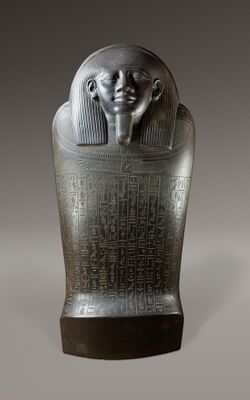
Both the Tabnit sarcophagus and the Eshmunazar II sarcophagus are thought to originally date from the Twenty-sixth Dynasty of Egypt, which had its capital at Sais.[2] This is partially due to their resemblance to similar sarcophagi such as the Psamtik II-era Horkhebit sarcophagus from Saqqara, now in the Metropolitan Museum of Art.
Notes
- ↑ Nitschke 2007, p. 71: "Three of these Egyptian sarcophagi manufactured during the twenty-sixth dynasty were apparently acquired by the Sidonians, perhaps as a result of Phoenician participation in Cambyses’ conquest of Egypt in 525 B.C."
- ↑ 2.0 2.1 Nitschke 2007, p. 72.
- ↑ Christopher B. Hays (2010), Re-Excavating Shebna's Tomb: A New Reading of Isa 22, 15-19 in its Ancient Near Eastern Context, Zeitschrift für die Alttestamentliche Wissenschaft; "The similarity of the inscription to that of Tabnit of Sidon (KAI1.13, COS2.56) is remarkable, extending even to the assertion that there are no precious metals within"
- ↑ Hamdi Bey & Reinach 1892a, p. I.
- ↑ Jessup 1910, p. 507a: "On the 14th of March a letter came from Mr. Eddy of a wonderful discovery in Sidon of ancient tombs, containing some white polished marble sarcophagi of exquisite beauty and marvellous sculpture. Mr. Eddy had been into the tombs hewn in the solid rock thirty feet below the surface and had measured and described all the sarcophagi of white and black marble with scientific exactness. On the 21st Dr. Eddy received from his son an elaborate report on the discovery which was intended to be sent to his brother Dr. Condit Eddy in New Rochelle. I obtained permission to make a copy for transmission to Dr. William Wright of London, and sent it by mail the next day. Dr. Wright sent it to the London Times with a note in which he expressed the hope that the authorities of the British Museum would "take immediate measures to secure these treasures and prevent their falling into the hands of the vandal Turk". The Times reached Constantinople. Now it happened that the department of antiquities at that time as now was under the charge of Hamdi Beg, a man educated in Paris, an artist, an engineer, and well up in archaeology. When he saw that article of Mr. Eddy's in the Times and Dr. Wright's letter, he said to himself (as he afterwards told us), "I'll show what the 'Vandal Turk' can do!"
- ↑ Jessup 1910, p. 507b: "One sarcophagus, when the lid was opened, contained a human body floating in perfect preservation in a peculiar fluid. The flesh was soft and perfect in form and colour. But, alas, while Hamdi Beg was at lunch, the over-officious Arab workmen overturned it and spilled all the precious fluid on the sand. The beg's indignation knew no bounds, but it was too late and the body could not be preserved, and the secret of the wonderful fluid was again hidden in the Sidon sand."
- ↑ Gubel, Eric (2003), "Phönizische Anthropoide Sarkophage by Katja Lembke", Bulletin of the American Schools of Oriental Research 332: 98–100, doi:10.2307/1357812
- ↑ Hamdi Bey & Reinach 1892, pp. 101–103:"Alors seulement nous pûmes enfin voir l'intérieur du sarcophage. Une couche de sable jaunâtre et humide de laquelle émergeaient la face décharnée, les clavicules, les rotules, ainsi que le bout des pieds auxquels manquaient les doigts, remplissait le fond de la cuve jusqu'à 25 centimètres de ses bords... Débarrassé du couvercle, je fis d'abord tirer de la cuve le corps du roi et j'ordonnai de l'étendre sur une planche pour l'emporter dehors et le confier au docteur Mourad Effendi, médecin municipal de Saïda, que j'avais chargé de le mettre en état d'être transporté à constantinople; car tous les muscles des parties postérieures ainsi que tous les organes internes du thorax et de l'abdomen étaient parfaitement conservés. Apres avoir fait vider la cuve, je conservai une portion de la boue formée de sable et de pourriture qu'elle contenait, et je fis passer le reste à travers un crible quand cette boue eut été, au préalable, délayée dans l'eau. Rien n'y a été trouvé, si ce n'est quelques fragments d'anneaux en argent."
- ↑ Context of Scripture 2.56, P. Kyle McCarter, "The Sarcophagus Inscription of Tabnit, King of Sidon", Brill Online, 2014
- ↑ Maria Giulia Amadasi Guzzo; Gary A. Rendsburg (2013). "Phoenician/Punic and Hebrew". Encyclopedia of Hebrew Language and Linguistics (Koninklijke Brill) 3, P-Z. ISBN 978-90-04-17642-3. https://jewishstudies.rutgers.edu/docman/rendsburg/587-ehll-phoenician-punic/file.
- ↑ HAELEWYCK, Jean-Claude (2011). "L'inscription phénicienne de Tabnit (KAI 13) Essai de vocalisation". Res Antiquae, Safran Publishers VIII. https://www.academia.edu/38976606.
- ↑ "Metropolitan Museum of Art". https://www.metmuseum.org/art/collection/search/548211.
References
- Hamdi Bey, Osman; Reinach, Théodore (1892) (in fr), Une nécropole royale à Sidon, doi:10.11588/DIGLIT.5197, http://digi.ub.uni-heidelberg.de/diglit/hamdybey1892bd1 (editio princeps)
- Hamdi Bey, Osman; Reinach, Théodore (1892a) (in fr), Une nécropole royale à Sidon: fouilles: Planches, doi:10.11588/DIGLIT.5198, http://digi.ub.uni-heidelberg.de/diglit/hamdybey1892bd2 (Plates)
- Jessup, Henry Harris (1910), Fifty-Three Years In Syria, 2, Fleming H. Revell Company, p. 507, https://archive.org/stream/fiftythreeyearsi011830mbp#page/n129/mode/2up
- Gottheil, Richard (1889), "The Inscription of Tabnit", Hebraica 5 (2): 197, doi:10.1086/369051
- Bommas, Martin (2006), "Die hieroglyphischen Texte auf dem Sarg des Tabnit", Orientalia 75 (1): 15, https://books.google.com/books?id=aOA8xpJZhjgC&pg=PA1
- Assmann, Jan, "Zur Baugeschichte der Königsgruft von Sidon", Archäologischer Anzeiger: 690–716, http://archiv.ub.uni-heidelberg.de/propylaeumdok/1700/1/Assmann_Zur_Baugeschichte_der_Koenigsgruft_von_Sidon_1963.pdf
- Nitschke, Jessica (2007), Perceptions of Culture:Interpreting Greco-Near Eastern Hybridity in the Phoenician Homeland, University of California, Berkeley, https://www.academia.edu/1561148
- Torrey, Charles (1902), "A Phoenician Royal Inscription", Journal of the American Oriental Society 23: 156–173, doi:10.2307/592387
